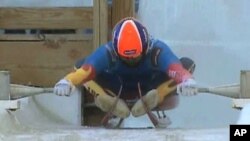The death of Georgian Olympic Luge slider Nodar Kumaritashvili while practicing at the Whistler Sliding Center north of Vancouver, Canada, highlights the dangers of the sport of Luge. Such deadly incidents are a rare occurrence during an Olympic games, and underscore the importance of safety for all athletes in competition. Kumaritashvilli's death could have far reaching implications for all Olympic events that utilize an icy sliding course.
USA Luge slider Tony Benshoof likes to speed. He gets a rush from hurling his body down an icy sliding track on a small sled, sometimes traveling faster than 160 kilometers an hour.
"At those high speeds the position on the sled is crucial, but when you are going around some of those corners and hitting 5 G's, that's easier said than done," he said.
The final turn at the Whistler Sliding Center, site of the Luge competition for the 2010 Winter Olympics, proved deadly for Georgian slider Nodar Kumaritashvili, 21. He suffered fatal injuries when he hit a metal beam after flying off the course during a practice run hours before the opening ceremonies.
The sport of Luge is the fastest sliding sport in Olympic competition. Its debut at the 1964 Winter Olympics at Innsbruck, Austria, also was the first time a Luge slider died while practicing for Olympic competition.
Kumaritashvili's was the second - and is unacceptable, says Georgian President Mikheil Saakashvili.
"No sports mistake is supposed to be fatal," said Saakashvili.
Saakashvili rejected suggestions the accident was a result of human error, but acknowledged Kumaritashvili might not have been as experienced as other athletes.
"This sport of Luge, as I found out, it is a matter of experience, and experience comes with years," he added.
In an interview in the months leading up to the Olympics, Benshoof explained how training for the Luge better prepares athletes for the Olympic competition.
"It takes a long time to get good at it. Most of the veterans in the sport are in their 30s because it takes so many years to get good and be a world contender," said Benshoof.
The Whistler track re-opened for competition just one day after the death of the Georgian slider. Even though some changes were made to ease athletes concerns, speculation continued about the overall safety of the course.
"We work very much with the international federations, and ultimately what they ask for us to design and to create is what we design always, of course, with safety as the top priority," said Vancouver Organizing Committee spokesperson Renee Smith Valade
Smith added that the track was certified by both the International Luge Federation and the International Bobsleigh and Tobogganing Federation prior to the Olympic games.
"At the end of the process, after the track is finished there is something that happens called homologation, and homologation is the formal seal of approval of the track from the two sport federations who say this track is certified for competition and training. So it goes through a rigorous process of development from the design phase right through the testing," he explained.
Though too late to change the overall course design for the Vancouver Games, organizers for the 2014 Winter Olympics in Sochi Russia are using Kumaritashvilli's death as a lesson in design and safety. The plan for the sliding track there still needs approval.
It is a track Tony Benshoof probably won't experience. Because of his age, he says he plans to retire from Olympic competition after the Vancouver games, even though he failed to get a medal.







